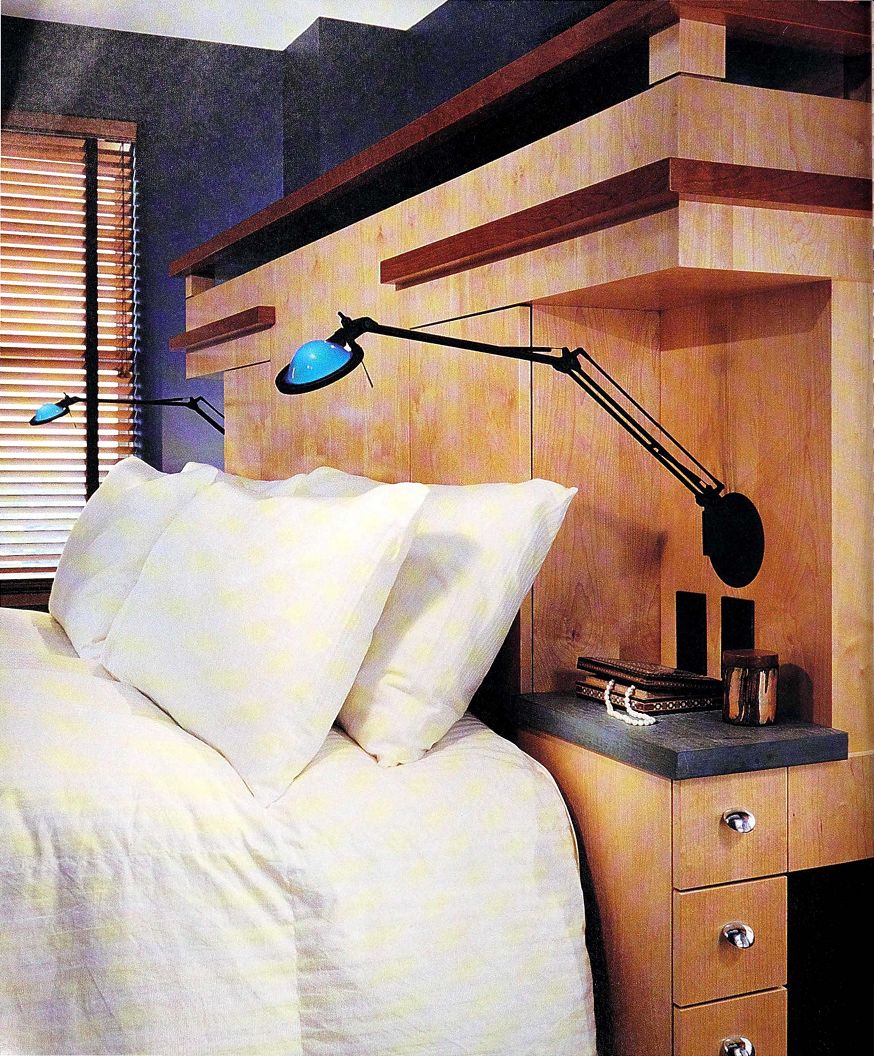
------- This unique unit offers bed, headboard, storage, and display
all in one. Multiple levels of storage are devised with drawers of various
sizes, and hidden cabinets make use of the back side of the unit without disrupting
its sleek look. For these committed in-bed readers, light fixtures built into
the headboard are a blessing. The unit also functions as a partition, subdividing
and defining this spacious room.
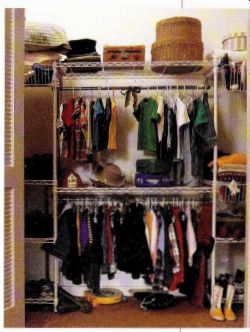
---------- Well-designed closet storage, like the system shown here, offers
a combination of rods and shelves, which ensures that each piece of clothing
can be stored in the manner that suits it best.
Of all the rooms in a house, the bedroom has the potential for the most eclectic assortment of storage. In a smaller house, the bedroom might contain the only available space for a desk and computer, while the ideal master bedroom in a big house may call for an entertainment center and have a suite of rooms attached.
Whatever extras you have in a bedroom, it's clothing that annexes most of the storage space, even if you're lucky enough to have this space in an adjacent dressing room or walk-in closet. In fact, most bedroom storage is found behind closed doors, from wall closets to full-blown dressing suites, supplemented by chests of drawers or built-in cabinetry. The balance of bedroom storage is devoted to the things you need for sleeping and waking, such as a stack of books and an alarm clock, and to the creature comforts that you choose to surround yourself with.
============
Where to Store Clothes
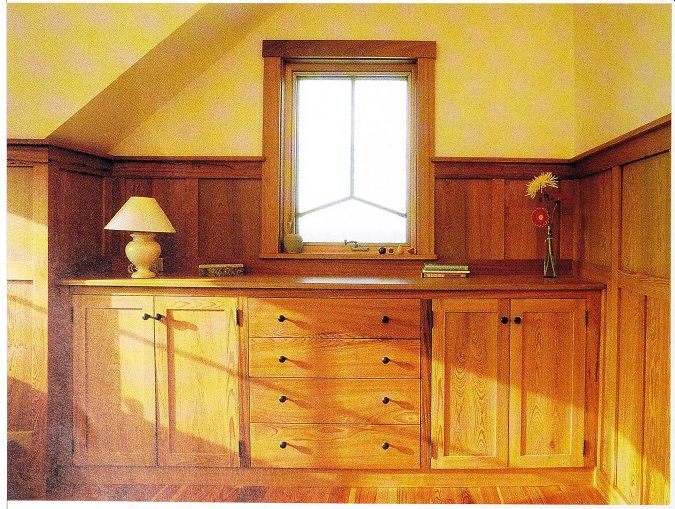
------------ This built-in bureau is integrated with the room's architecture
and paneling, creating both a beautiful composition and an abundance of storage.
Like the kitchen pantry with its 10 brands each of cereal, cookies, and soup, today's closet has to handle a colossal variety of clothing, most of which our ancestors never dreamed of; we have far more specialized clothes than some earlier generations-just compare your wardrobe with that of your great-grandmother. You may wear stretchy, space-age gear for biking, white togs for tennis, overalls for gardening, casual clothes for home, different casual clothes for going out, skirt and pantsuits for work, elegant clothes for evening, and lounging wear for various seasons--not to mention the many accessories that go with them.
Keeping clothes orderly and accessible is no minor task.
The traditional chest of drawers or an armoire is a start but rarely provides adequate storage . However, freestanding cabinetry can add much to a bedroom's ambience, so it should be selected with an eye toward aesthetics as well as function.
Freestanding furniture is generally supplemented by a closet (if your bedroom doesn't include one, consider going to any length to create one), be it the standard 2-ft.-deep wall closet or a room-size walk-in. In either event, storage space will go a lot further if the closet is properly outfitted with well-thought-out shelving, hooks, rods, and cubbies. While internal storage systems can be custom designed, they've become widely available off-the-shelf, and you can practically buy your way to custom storage, thanks to the myriad modular units in the marketplace. In-the-closet cabinetry also has a lighter load and fewer viewers than the cabinetry in your kitchen, living room, or study, so it can be detailed more simply and focused on function rather than form. However you store your clothes, keeping them neat and accessible is the key to a good start in the morning.
Furniture for Clothes
Chest of drawers, bureau, armoire, dresser, chiffonier, whatever you call your freestanding furniture for clothing, chances are it's furnished mostly with drawers. Go for an assortment of depths, if possible, or fit it with compartments that keep items from deep tangles. Line with shelf paper or cloth to avoid staining from unfinished interiors, especially from cedar-lined drawers. Drawer storage is best for small items, such as lingerie, underwear, socks, swimsuits, exercise clothes, belts, and the like. Sweaters and knit shins can be stored in drawers, but they are easier to see and access on fixed or pullout shelves.
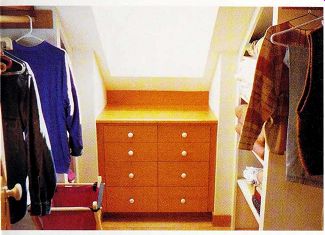
--------- A skylight that creates headroom and light in this closet also
makes the perfect niche for a built- in bureau. Clothes hang in easy reach
on either side.
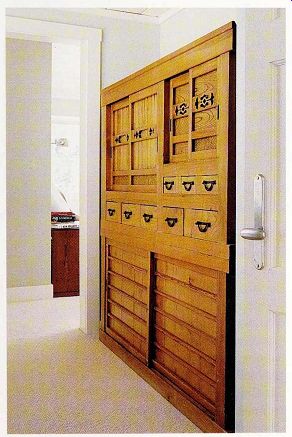
--------- A treasured family heirloom, this antique tansu chest has a highly
visible but out-of-the-way spot nestled in a recessed niche near the entryway
to the master bedroom suite. Its variety of drawers and cabinets handle an
array of storage needs.
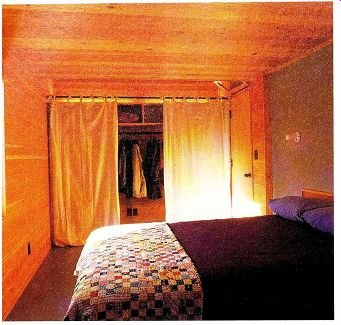
------------ Storage doesn't have to be fancy to be functional. This simple
closet, concealed by a curtain rather than a door, takes care of storage necessities
while adding charm and openness to a small, rustic bedroom.
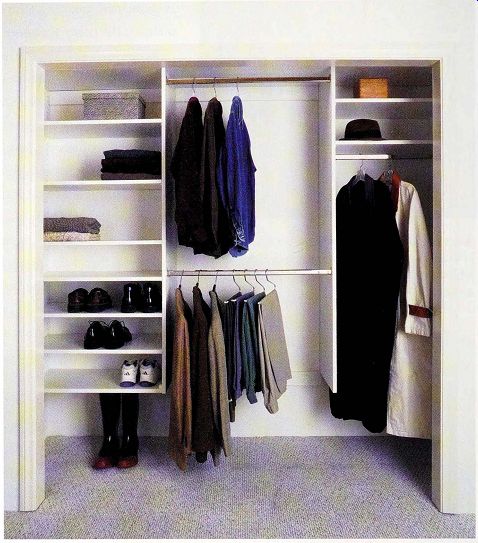
------------- This is a setup photo, of course-who has a closet that looks
like this?-but it illustrates the point that different types of clothes require
different types of storage. Single poles are necessary for long items, but
doubling up rods makes the most efficient use of space and is acceptable for
most clothes. Adjustable shelves handle a variety of needs from hats to sweaters
to shoes.
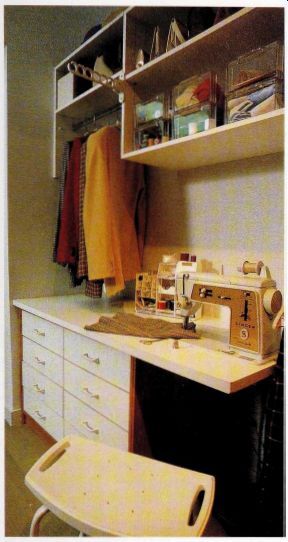
----------- This dressing room is a clothes aficionado's dream.
It has every kind of storage a couple needs, including hooks, poles, shelves, drawers, and enough room to park a car. The rods are perfectly designed for maximum efficiency, accommodating garments of any length, while the shelves are varied to hold shoes and boots of all sizes.
At the far end, a sewing station resides in easy reach of clothes that need repair; the desk it sits on provides even more drawers and shelves for sewing supplies and other paraphernalia.
Wall Closets, Shallow and Deep
The most basic of wall closets is a standard 2 ft . deep and generally contains a single shelf positioned 68 in. off the floor, along with a rod that's 1 in. to 2 in. just below the shelf; long spans wilt require a midspan bracket for the pole.
If this arrangement suits you, count yourself lucky, but most of us could do with a little more variety-and depth. Just an extra 6 in. will allow better access to shelves installed along the side walls and more room for storage on the back of the door, which is a good place for shoe pockets, tie and belt racks, and other hanging accessories. Home-design stores and catalogs offer an array of closet systems that provide drawers, shelves, rods, and hooks that you can mix and match at will. A wall closet that's built into a wall under a gabled roof can be extended into the knee-wall space, where it's possible to hang a lower rod for out-of-season clothes.
Off-the-shelf storage systems are made in several materials, from wire to plastic to panel products (panel products include particleboard, medium-density fiberboard (MDF) , plywood, and combination products) . For shelves and drawers, wire systems allow clothes to breathe, but they will leave an imprint on fine knits; solid shelves are a better choice for delicate folded items.
============
Safe Storage
Bedrooms often become the repository of safes.
Smaller safes can be installed after the house is built, but large or built-in safes require forethought.
A large safe can damage a floor as it's hauled into place, so protect floors carefully or, if you're building, plan to finish them after the safe is installed. A safe that is bolted to the floor will provide the most security from burglary, of course, but it can't be moved in case of a fire. No safe is completely fireproof, but fire-resistant safes are available. If you're building and plan to include a built-in safe, don't note its location on house plans.
There's no need to spread the news around a job site, and you'll probably need to file a set of those plans with the town hall, where even more eyes would be privy to its location.
===========
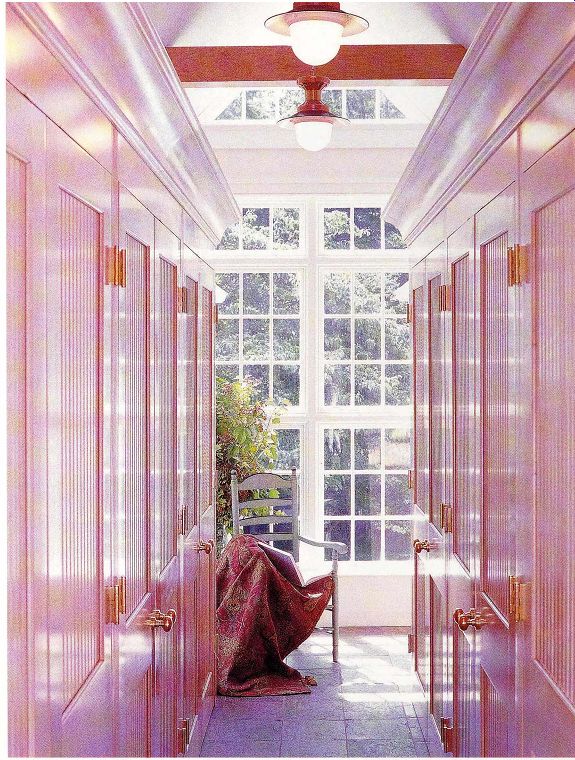
---------- This dressing hall , situated off the bedroom, is an elegant
space, with beaded panels in flat frames along with glass hardware. The multitude
of doors conceals all the shelves, closet poles, drawers, and hooks that this
couple requires for clothing storage. The floor-to-ceiling window lets in lots
of light and offers a relaxing view of a private garden.
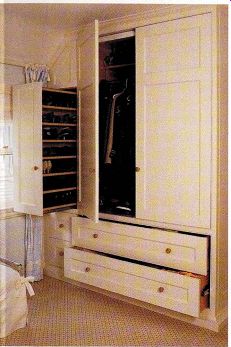
---------- This handsome, built-in cabinet efficiently houses an entire
wardrobe. Shoes are kept in a pullout un it, drawers handle folded clothes
and lingerie, and a single closet pole maintains hanging clothes, with hats
and belts coiled or stacked on the raised cabinet floor. Off-season clothes
are culled regularly and stored in hall closets outside the bedroom.
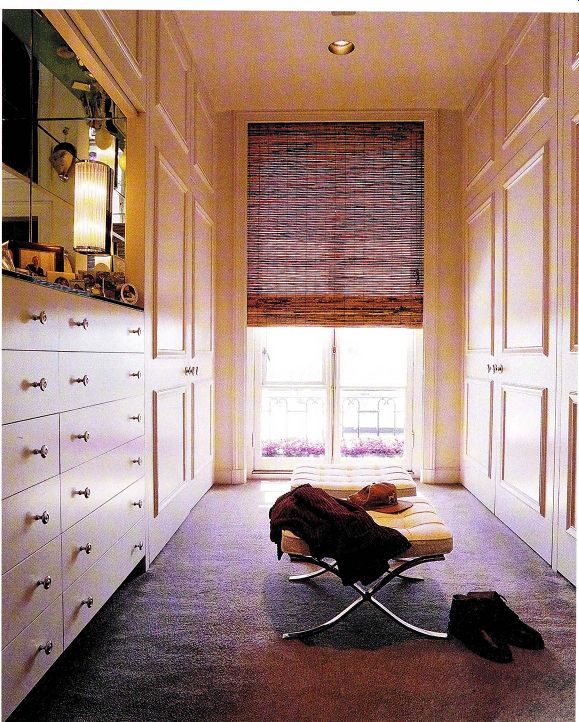
---------- This dressing room keeps everything in its place, with paneled
doors concealing hanging clothes and plenty of drawer storage for accessories
and folded clothes. A niche with mirrored sides and back provides a three-way
view during dressing.
Walk-In Closets and Dressing Rooms
A walk-in closet doesn't necessarily have the space you need to dress, so you can call a big walk-in closet a dressing room, especially if it's fitted with a dressing table and a mirror (a three-way mirror, if you have the space and the courage) . If you can, design a walk-in closet to specifically suit you and your collection of clothes. Count and measure all the items you'll be keeping and build in some space for adding clothes (and shoes!). The ideal dressing room has the space to provide storage in many forms, and will provide room to change clothes easily. Include a hamper in the dressing room, as well as a trash can for the daily debris culled from pockets, a bowl for loose change, and tools for taking care of clothes, such as brushes, sewing tools, and possibly an ironing board and a steamer. Of course, the dressing room should be adjacent to the master bathroom, and to the washer and dryer if your preference is to wash clothes near bedrooms and bathrooms rather than near the kitchen or in the basement.
How to Store Clothes
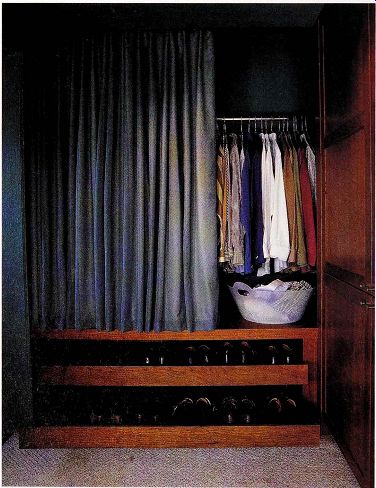
------------ A tidy shirt closet actually makes dry cleaner hangers look
appealing, with shirts neatly hung on a chrome closet pole. A translucent plastic
bin holds shirts ready for the cleaners. The satiny curtain door provides a
rich contrast to the flat-framed cherry cabinetry, which conceals folded clothing.
Cherry pullout shelves keep shoes neat and easy to access.
Whether clothes are stored in dressers, wall closets, or dressing rooms, here are some basics for organizing clothes to keep them in good shape while getting the most from the available space . The first step is to organize clothes by type; the exception is an unimpeachable ensemble, which should be stored together. Store clothes to their best advantage, keeping in mind how they are made and how you wear them. Even off-season or rarely worn clothes should be hung properly with enough room to breathe; consider installing a secondary rod rather than squashing them in with your active wardrobe. Another important step in preserving your clothes is to remove plastic dry-cleaner bags immediately and let the clothes air out for a day or two before putting them away.
Clothes to Hang
A majority of clothing is best stored hanging. But how you hang items will determine whether you have a wrinkled mess or a functional wardrobe. Taking time to measure and think out your closet needs will make a huge difference in how well your closet operates, and thus, how smooth or annoying the task of dressing is. Here are some guidelines to get you started.
Poles--Dresses, blouses, shirts, coats, trousers, and skirts are best stored on hangers, so the more closet poles, the bet ter. Short spans for each type of clothing work the best.
HANGERS -- The right hanger goes a long way in ensuring tidy closet storage. Use tubular, plastic hangers for shirts, padded-shoulder hangers for slippery blouses and delicate knits, and wood or plastic hangers with bowed backs and trouser bars for pantsuits. If you prefer to hang pants without a centerfold, use hangers with clips and adjust the height of the rod to accommodate the length of the pants-long skirts will require the same.
Pegs ------- You won't want to store dresses, blouses, and shirts on pegs or hooks, but don't ignore these handy devices. You'll need them for robes, towels, work shirts, overalls, and possibly bel LS and scarves.
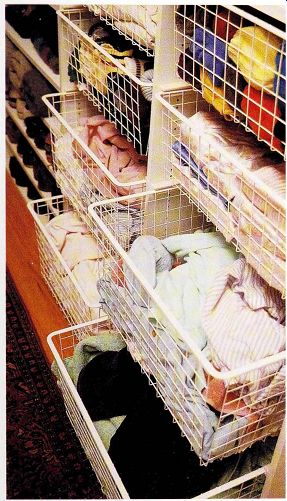
------------ You have almost infinite options for shelving heights in this
dressing room, with holes for pins drilled closely together. Shelves, solid
drawers, wire pullout baskets, hooks, and rods supply a multitude of storage
needs.
Sweaters are best folded so they won't stretch on hangers, belts are hung, socks and jammies are in pullout wire baskets, and underwear is stashed in closed drawers.
Clothes to Fold
It's best to fold knits rather than hang them, but some sweaters can be folded and hung on the bar of a hanger, preferably a thick one with a nonslip surface. Adjustable shelves will allow for customized spacing, but be sure to order enough ; it's better to space shelves closely for folded items--a sky-high stack of sweaters is not only unwieldy, but it makes for more wrinkles and less ventilation. Keep like items stored together, even if it means only one item per stack; this will prevent you from rummaging through multiple shelves and messing up all the piles.
Finding Storage Pockets
The bedroom is personal, private space, and carving out storage from corners, eaves, and walls provides a wonderful opportunity to add charm and coziness to the room. Because many bedrooms are located on the top floor, it's often possible to make use of roof shapes for captured storage space, whether in a knee wall or in the interesting thickened walls made by dormers that intersect gabled roofs.
Built-in drawers or closets can make use of space that is otherwise wasted, and designing storage in this way customizes it to your specific needs, while adding a unique and interesting touch to your bedroom.
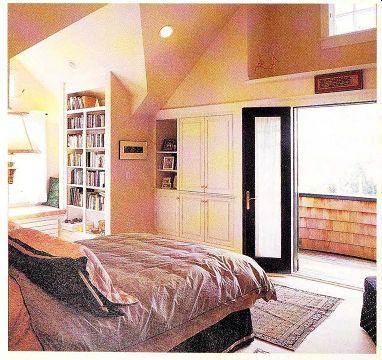
----------- This master bedroom uses intersecting roof lines to create
interesting storage opportunities.
A bookshelf is built into the dormer wall, and two built-in cabinets flank the balcony doors; the one to the left contains a television and audio system.
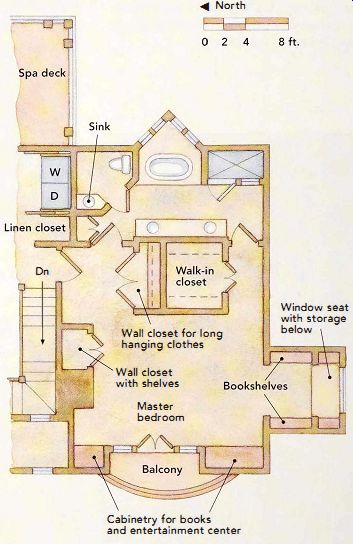
------------------ A House That Works Storage into the Architecture
==========
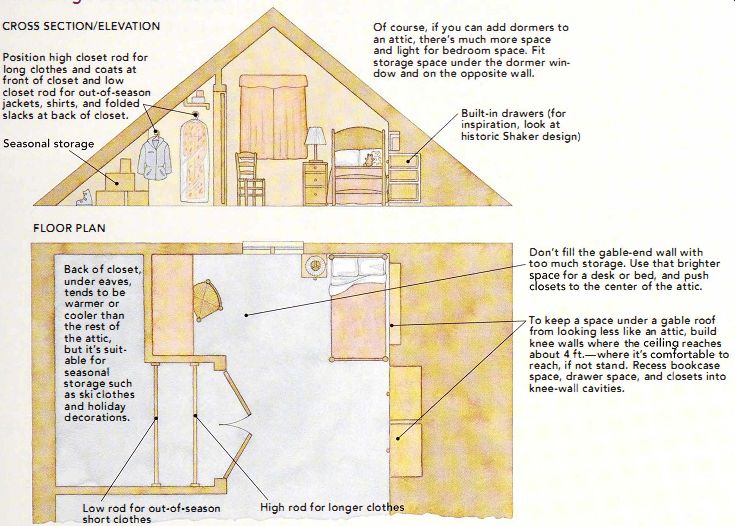
Fit Storage under the Eaves
CROSS SECTION/ELEVATION
Position high closet rod for long clothes and coats at front of closet and low closet rod for out-of-season jackets, shirts, and folded slacks at back of closet.
Of course, if you can add dormers to an attic, there's much more space and light for bedroom space. Fit storage space under the dormer window and on the opposite wall.
Built-in drawers (for inspiration, look at historic Shaker design)
FLOOR PLAN
Back of closet, under eaves, tends to be warmer or cooler than the rest of the attic, but it's suitable for seasonal storage such as ski clothes and holiday decorations.
Don't fill the gable-end wall with too much storage. Use that brighter space for a desk or bed, and push closets to the center of the attic.
To keep a space under a gable roof from looking less like an attic, build knee walls where the ceiling reaches about 4 ft.-where it's comfortable to reach, if not stand. Recess bookcase space, drawer space, and closets into knee-wall cavities.
==============
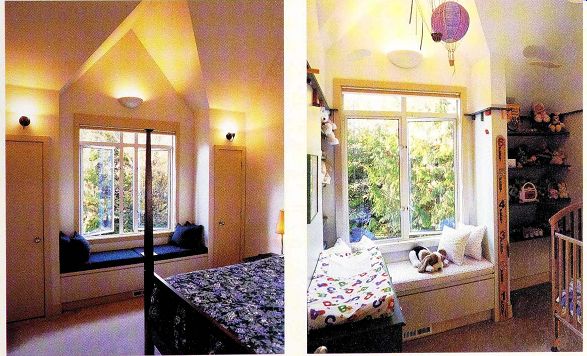
------------- The dormer in this small room (far left) creates space for
a window seat with storage, while lending visual interest and an expanded sense
of height and depth. Although this room is only 11 ft. by 15 ft.-small for
today's master bedrooms it feels ample and elegant.
------------ The baby's room has the same dormer configuration as the master bedroom, but the corners are left open with shelves for toys.
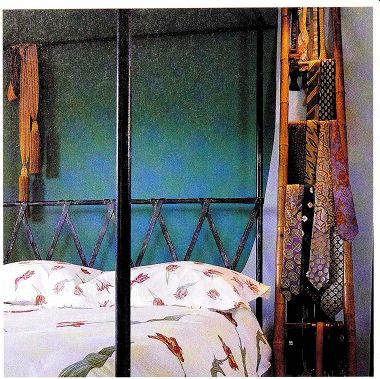
-------------- A bamboo ladder leaning against the wall makes an attractive
and handy rack for ties and belts.
Wire shelving will make marks on sweaters and fine knits, but they're a boon for shoes, hats, and other items that benefit from a good airing. If your shelving is built-in and will be finished on site, take heed of the tip offered for shelving in pantries and give closet woodwork a glossy or satin finish, and al low finishes to dry completely.
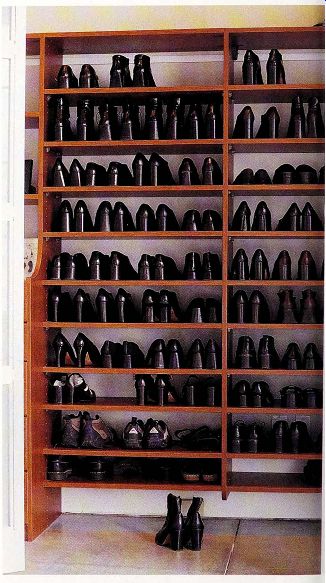
----------- Anyone who loves shoes-but hates the tangled mess they make
on the floor-would love a closet like this, with adjustable shelves that offer
many rows to neatly fit many shoes.
=========
His-and-Her Closets
In this Martha's Vineyard house, the master bedroom suite contains his-and-her dressing rooms that have the same basic design but different arrangements. Each has built-in drawers, a bench, and closet rods of varying heights. Drawers have scooped-out pulls for easy opening. To give the closets a more spacious feel and to maximize natural light from the skylight, the walls are stopped short of the ceiling; the resulting boxes are trimmed with molding and Craftsman-style brackets. A chest, which was custom-built for the room along with the bed, holds blankets and extra bed linens.
All the furniture and trim is built from reclaimed cypress, which designer South Mountain Company calls its "bread-and-butter" wood. Reclaimed cypress is timber that sank to river bottoms when old-growth cypress forests were heavily logged a century ago. This dense wood has lots of warmth and character and is easy to work into furniture and molding. The floor is reclaimed pine.
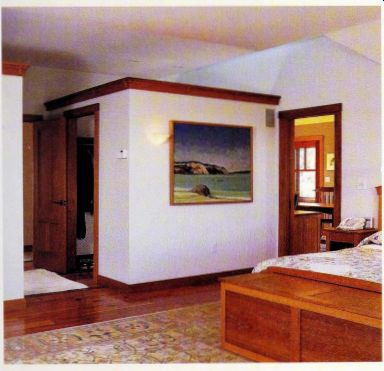
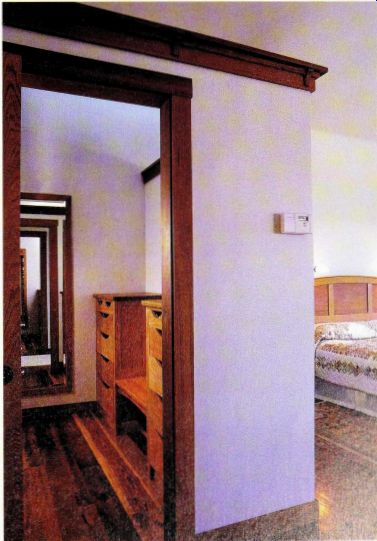
--------- The two closet boxes are stopped short of the ceiling to take
advantage of natural light.
Positioning the closets at the entry to the bedroom makes for a more private entrance into the room. The couple's joint study is beyond the bed.
===========
Storing Accessories
Accessories can take over a closet, so it makes sense to dedicate space to storing them efficiently. There's no shortage of closet accessories that store accessories, but to figure out exactly what you need, you may want to take a field trip to your favorite clothing store and learn from the way they store accessories; if they're doing it right, everything should be easy to access and just as easy to put back.
The best tie-storage methods keep all ties easy to see and get to, which means not on a tie hanger that's tucked between shirts. Fine men's-clothing stores always store ties flat so that ties, which are bias-cut, won't stretch. This method is harder to accomplish at home, but if there's enough space, ties can be folded and stored in hallow drawers or on pullout shelves. Hanging ties over pegs on a wall rack is a happy compromise.
Shoes are best stored off the floor on eye-level shelves or in pull-out units, where they won't be kicked around and separated from their mates. If shoes have to stay at floor level, consider an adjustable shoe rack that will stretch along the back or side wall of the closet. Otherwise , store shoes in pockets or on a shoe rack that fits on the back of the door.
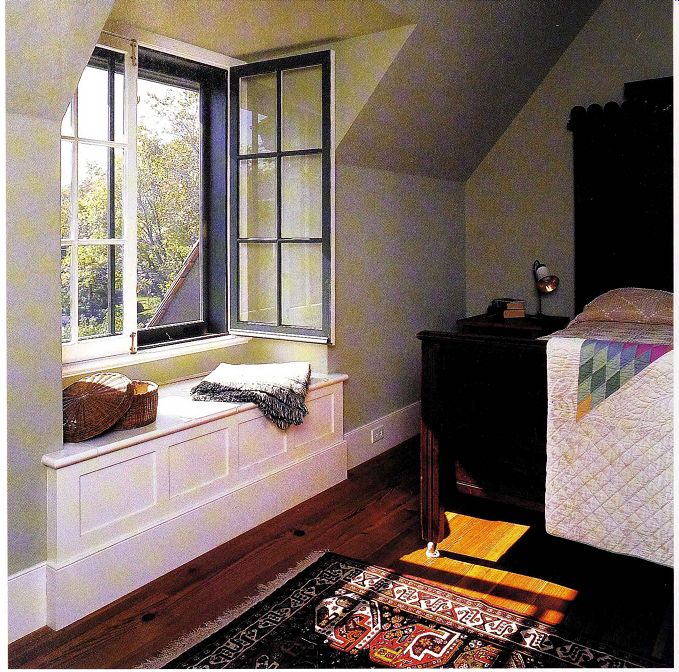
------------ In this bedroom, a sloped roof with a dormer makes a cozy
window seat that also provides storage for off-season clothes. The seat has
hinged panels that allow for easy access.
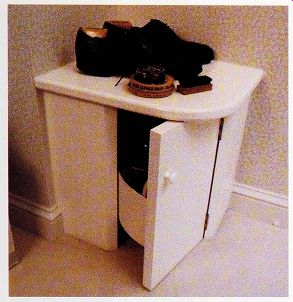
------------ This cupboard, located in a dressing room, is designed
to store shoe-shining equipment a nice extra for the truly shoe obsessed.
Belts
Belts can be coiled and stored in individual slots in a shallow cabinet or in a partitioned drawer, in clear pockets in a hanging rack, or on individual pegs on the wall. But beware of stacking belts on pegs; you'll always want the belt at the back of the stack.
Hats
Fine hats must be stored under wraps in hat boxes with protective tissue and some ventilation. Caps are most easily seen and accessed if they are hung on pegs rather than set on shelves or thrown in a basket. Soft hats, such as berets, will stretch on pegs, so keep them neatly stacked on shelves.
======
Discouraging Moths
The first storage myth to dispel is that a cedar closet will keep moths away from woolens. It's true that cedar oil can kill young larvae, but it has not been proven to kill adult moths and eggs, and it's not known what amount of cedar oil will do the trick. Only naphthalene and paradichloro-benzene (found in mothballs) are proven to kill moths in all stages and only if not diluted by too much air circulation.
But both of these chemicals are toxic (the latter is carcinogenic), and clothes stored with mothballs should be isolated from rooms where you spend time.
Consider discouraging moths from your woolens in a safer way. Moths love grease, sweat, food stains, and starch, so the very best way to prevent moth damage is to brush woolen garments after you wear them and to clean and brush all garments before putting them back on shelves, in drawers, or in chests. It's also wise to clean containers and closets before loading them up with long-term or off-season storage; also keep this long-term storage as cool and dry as possible.
Since cedar does provide some discouragement to moths, there's no harm in using it to line drawers, trunks, and closets that are used to store out-of-season wool clothing. Line cedar containers with a clean sheet or muslin before storing woolens, however, because the cedar can stain light-colored fibers.
========
Storing Out-of-Season Clothes
Most of us have far too many clothes to keep in active storage all year. Off-season clothes can be stored in a commodious bedroom closet, but if space is at a premium, they are perfect candidates for out-of-the-way storage niches, from the top shelf of a closet to storage drawers or boxes under beds.
All clothes should be cleaned before they are put away, and boxes should be labeled so it's easier to unpack when the temperature changes.
Avoid lining boxes with, or storing hanging clothes in, dry-cleaner bags, which don't let clothes breathe and may discolor delicate fabrics. If there's closet-rod space available, consider purchasing cloth or nylon garment bags for hanging storage or bags with slots for storing knits and shoes. Another option is a rolling rack fitted with a canvas tent, which protects clothes from dust and humidity; this can be rolled into a spare bedroom or even the basement or attic as long as those areas are free from dampness and vermin and have a stable temperature . Archival boxes and tissue are the best bet for long-term storage of favorite clothes that will become heirlooms. Keep all storage containers away from excessive heat and humidity.
The Bed
The bed is the centerpiece of most bedrooms, and while it can take up considerable space and require adjacent storage , it can also provide storage. Beds themselves can be stashed in unexpected places, even places other than a bedroom, or under eaves and in walls to make either a cozy space for sleeping or a space that converts by day to a window seat or retreat for quiet activities.
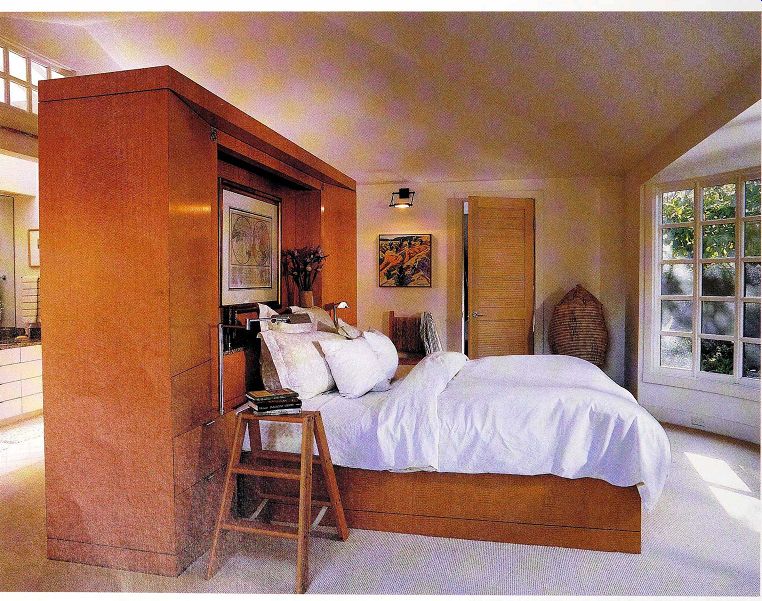
----------- The ultimate in bedside tables is a thick wall devoted to storage.
This handsome wall-cum-headboard has a multitude of drawers and a shelf for
odds and ends. The remaining space in the unit is dedicated to storage that
serves the master bathroom (located behind it).
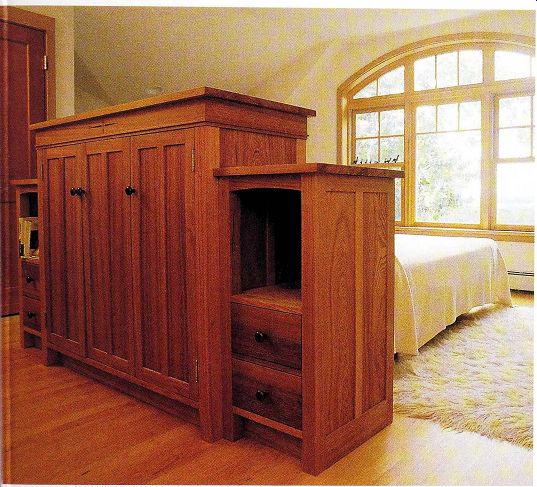
----------- This antiqued cupboard prevents stacks of reading material
from overwhelming the bedside, and the top drawer makes a handy place to stash
reading glasses and the like. A chest by the window contains blankets and extra
pillows.
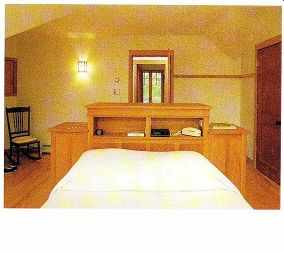
----------- This headboard operates as a storage unit and a room divider.
On the bed side it holds books, a clock, and a phone, and on the opposite side
it offers drawers for folded clothes and a cabinet with closed doors that conceal
shelving.
Bedside Storage
A bed without bedside storage is a sorry state of affairs.
Where else can you deposit bedtime books and magazines, a glass of water, your watch, a pad and pencil for noting midnight inspirations, and a clock radio? The bedside table is a time-honored tradition, but it's possible to provide bedside storage in other ways-by building shelves into a headboard or by tucking the bed into built-in cabinetry that contains shelves and drawers. The key to functional bedside storage is to make it easy to reach without falling out of bed, to keep open shelves away from where you will sit up in bed and lean against pillows, and to provide a light nearby that can be turned off from the bed. A lockable drawer is a handy addition if you require nighttime medications and live in a household with small children.
Storage under the Bed
The space under the bed can be used for more than dust bunnies and the errant shoe. It's perfect for long-term storage of off-season clothes or linens, luggage, or even of seasonal decorations. Since a bedroom is likely to be kept at a comfortable temperature, this may be the perfect spot for storing relatively fragile items, such as archived photographs. But keep storage to a minimum of containers, such as shallow rollout bins, and try to match the bin to the space available so that there's little chance for dust to collect. An off-the-shelf bin can hide behind a dust ruffle, or drawers and rollout shelves can be built into the bed frame itself.
Casters will make access much easier, and a zipper or flip top will keep dust and critters out of the contents.
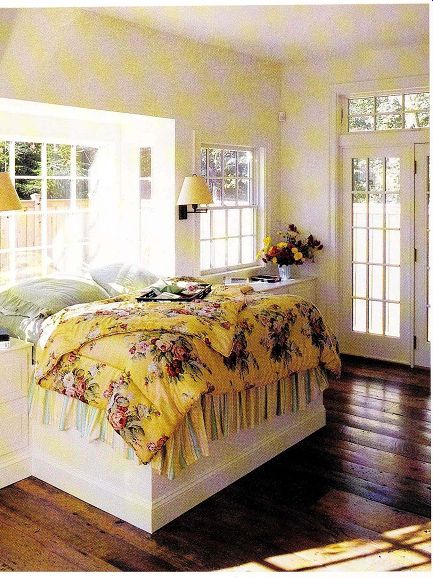
------------- This master bedroom bed is built into a south-facing bump-out
to take advantage of a solar alarm clock. Homeowners/newlyweds Mike Guertin
(a builder) and Susan Aitcheson (an architect) designed the cabinetry to incorporate
long drawers and generous surfaces for bedside storage (see the floor plan
below).

-------------- A House That Maximizes Bedroom Space
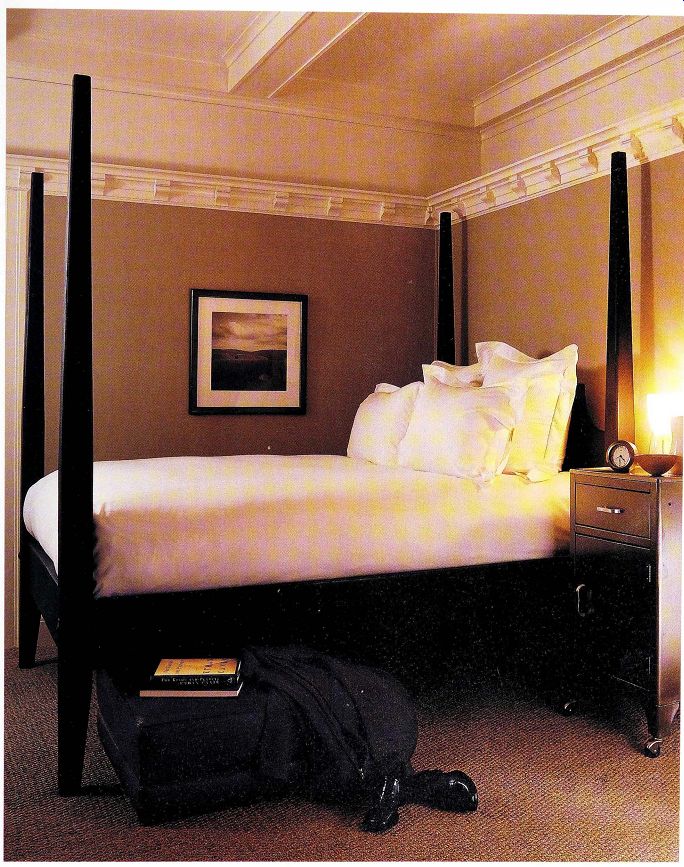
------------- A bed for one person needs but one bedside table. This heavy-duty,
stainless-steel cabinet keeps books behind a door and bedside odds and ends
in a drawer so the top can be kept relatively clear. The big leather stool
officially acts as a step up to the bed, but it also provides temporary storage.
Fitting In a Fold-Down Bed
Architect Patrick Camus and his wife, Lynnette, live in a 10-ft.-wide town house that doesn't leave much room for guests, but they found a way to be hospitable by squeezing a fold-down bed into a small spare room. Patrick was not enamored of the off-the-shelf, Murphy-style bed kits that he saw, so he designed and built one to blend seamlessly into accompanying cabinetry-until guests arrive, there's no indication that a bed exists. The center section of wainscoting, which is actually a box on wheels, pulls out and acts as both footboard and storage for a comforter. The center panel is a bed frame constructed of 3/4-in.-thick, 5-ft.-by- 10-ft. sheets of medium density fiberboard, which are rabbeted into a poplar frame that is the depth of a foam mattress. This bed frame is unbolted from the built- in shelves and carefully lowered to rest on the wainscoting/footboard.
The head of the bed remains hinged to the wall structure.
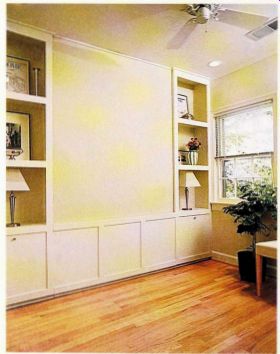
------------- This study doubles as a guest room in a small town house.
When closed, the bed is completely camouflaged by the wainscoting and wall
panel.
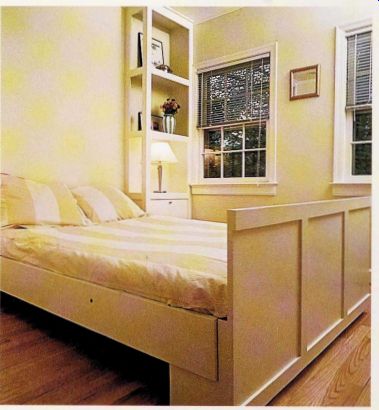
------------- The wainscoting rolls away from the wall to become a footboard,
then the panel is unlocked and lowered to rest on the footboard. The comforter
is rolled up and stored inside and the closed cabinets that flank the bed hold
pillows.

---------------- This whimsical chest of drawers has storage for all childhood
needs-drawers and closed cupboards for toddler clothes, open shelves for toys,
and rolling bins that make a game of cleaning up kiddy clutter.
Kids' Bedroom Storage
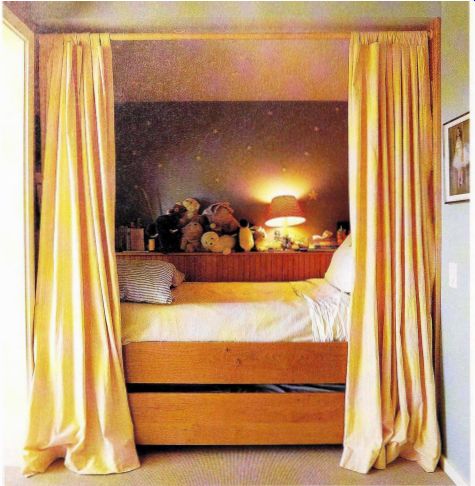
--------------- This child's bedchamber is a little world unto
itself, with a storage ledge for prized possessions, and a spare bed stored
beneath for sleepovers.
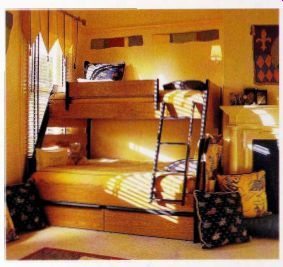
----------- In addition to providing a spare bed, this bottom bunk has
two large drawers for auxiliary storage .
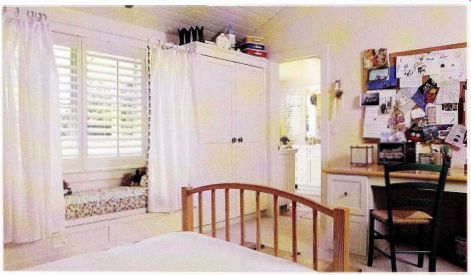
----------------- A room for a school-age girl incorporates a window
seat, which has drawers underneath for toys and games. Clothes are stored in
the adjacent closet, where short rods and lots of pegs provide easy access
to hanging items. A trunk at the foot of the bed holds off-season folded clothes
. Desk drawers corral art and school supplies.
They may be smaller than their parents, but kids often require more storage space in their bedrooms because unlike their parents, all their worldly possessions have to fit in one room. As they grow, kids' storage needs evolve, but the trick is to start low with storage and spread it out horizontally, making it easy for little kids to reach.
Provide lots of open shelving, and outfit the shelves with removable, shallow boxes to hold collections of toys and keep them orderly. Rolling boxes are ideal for use between the lowest shelf and the floor.
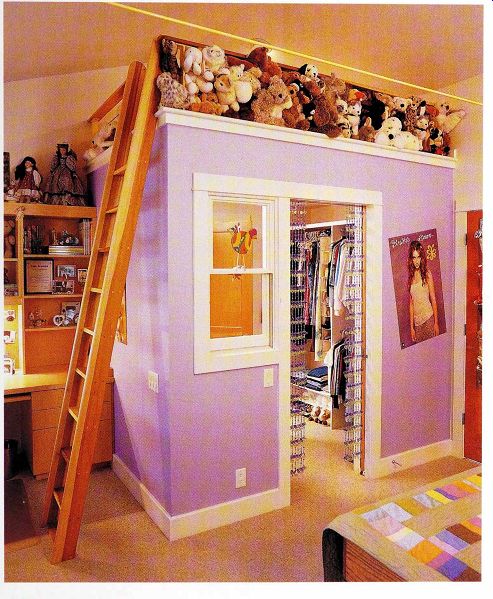
-------------- This closet-top loft provides a getaway space for a 10-year-old
girl, along with an enviable closet. Like a miniature playroom, complete with
a beaded curtain and a double-hung window, the closet keeps al l clothes in
view and easy to retrieve.
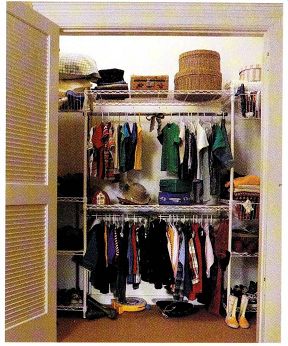
------------- It's hard to get kids to hang up clothes, but keeping at
least one clothes rod low will make that task a little easier. This wire shelving
unit handles hanging clothes and provides shelves for folded clothes and shoes.
Unlike adult closets, kid closets benefit from room on the floor to store toys
and shoes .
The floor is all a little kid needs for playing, but a kid-sized desk seems more grown-up and will help keep crayons and play clay off the carpel. Use storage furniture-chests of drawers, bunk beds, and shelving-for dividing a bedroom into cozy spots for various activities. Be very sure that tall furniture is secure and can't be pulled over by climbing kids.
Closets should be made kid-friendly by keeping everyday clothes within reach. Look for storage solutions that require the least amount of effort: pegs instead of hangers for robes, pants, and sweatshirts; sturdy plastic hangers instead of wire hangers; open shelves instead of shelves behind doors; drawers for small, loose items, such as underwear and socks. Chests of drawers look good in a room, but they work best for babies and teens. School-age kids approach drawers like a lazy gardener tills soil-the top 4 in. of clothes are worn and replaced, while the bottom stash (perfectly clean and possibly still in style) lay dormant below.
Instead, consider fitting a wall closet with shallow wire or plastic drawers and pullout shelve that allow clothes to be seen and worn--and sometimes even pull away.